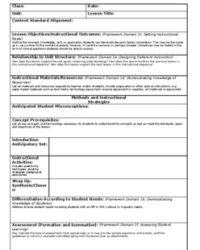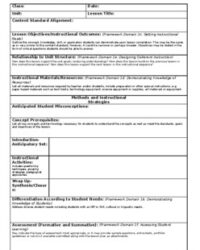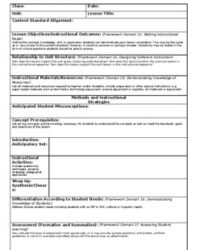Ever feel like lesson planning is a puzzle with missing pieces? You’re not alone. Many educators, new and seasoned, constantly seek ways to streamline their preparation while ensuring every lesson hits its mark. That’s where the Charlotte Danielson Framework comes in, offering a clear, comprehensive guide to effective teaching. It’s not just a set of standards; it’s a blueprint for excellence in the classroom, helping you reflect on and refine every aspect of your practice.
Imagine having a structured approach that covers everything from planning your objectives to managing your classroom and engaging your students. Utilizing a thoughtfully designed Charlotte Danielson framework lesson plan template can transform your lesson planning from a daunting task into an organized, reflective, and even enjoyable process. It ensures you’re not just creating lessons, but truly building impactful learning experiences.
Unpacking the Core of the Danielson Framework for Teaching
The Danielson Framework for Teaching is essentially a roadmap for instructional excellence, broken down into four distinct domains. Each domain focuses on a crucial area of teaching responsibility, providing a common language for educators to discuss and improve their craft. Think of it as a comprehensive checklist that empowers you to consider every angle of your teaching, leading to better outcomes for your students.
When you align your lesson plans with this framework, you’re not just ticking boxes; you’re engaging in a deeper level of professional reflection. It encourages you to move beyond simply stating what you’ll teach and prompts you to think about how you’ll teach it, how you’ll assess learning, and how you’ll create a supportive environment. This holistic approach is what makes the framework so powerful in fostering continuous growth.
Domain 1: Planning and Preparation – The Foundation of Great Lessons
This domain is all about what happens before you even step into the classroom. It’s where you define your learning objectives, design assessments, plan your instructional activities, and consider the resources you’ll use. A strong start here ensures clarity and purpose for your lesson. It includes:
- Knowledge of Content and Pedagogy
- Demonstrating Knowledge of Students
- Setting Instructional Outcomes
- Demonstrating Knowledge of Resources
- Designing Coherent Instruction
- Designing Student Assessments
Domain 2: The Classroom Environment – Cultivating a Learning Hub
Once your plan is solid, the next step is creating a space where learning can truly flourish. This domain focuses on establishing a respectful and positive learning environment, managing classroom procedures, and fostering student responsibility. It’s about setting the stage for engagement and active participation.
Domain 3: Instruction – Bringing Learning to Life
This is where the rubber meets the road. Domain 3 focuses on the actual delivery of your lesson. It covers everything from communicating clearly and using effective questioning techniques to engaging students in learning and providing valuable feedback. It’s about making your plans actionable and responsive to student needs in real-time.
Domain 4: Professional Responsibilities – Growth Beyond the Classroom
Finally, this domain looks at your broader role as an educator. It includes reflecting on your teaching, maintaining accurate records, communicating with families, participating in a professional community, and growing professionally. This ongoing self-assessment and engagement are crucial for long-term effectiveness.
Designing Your Own Charlotte Danielson Framework Lesson Plan Template
So, how do you translate these powerful concepts into a practical tool for daily use? Creating or adapting a Charlotte Danielson framework lesson plan template means structuring your planning document to naturally prompt you to consider each of the framework’s components. It’s about building in reflective questions and sections that guide your thinking, rather than just filling in blanks.
Your template should be intuitive and comprehensive, allowing you to easily map your instructional strategies to the framework’s expectations. Think about what specific prompts or sections would help you consistently address elements like student engagement, differentiation, or assessment alignment. The goal is to make a tool that truly supports your planning process, not just another piece of paperwork.
Here are some key sections you might want to include in your template:
- Lesson Title and Subject
- Grade Level and Duration
- Learning Objectives (aligned with Domain 1)
- Student Prior Knowledge/Needs (aligned with Domain 1)
- Materials and Resources (aligned with Domain 1)
- Classroom Management Strategies (aligned with Domain 2)
- Instructional Activities and Strategies (aligned with Domain 3)
- Differentiation for Diverse Learners (aligned with Domain 1 and 3)
- Assessment Methods (Formative and Summative) (aligned with Domain 1 and 3)
- Teacher Reflection (aligned with Domain 4)
Embracing the Danielson Framework, especially through a tailored lesson plan template, isn’t just about meeting evaluation criteria. It’s about empowering yourself as an educator to design truly effective and engaging learning experiences for every student in your care. It transforms planning from a routine task into a strategic endeavor, ensuring every minute in the classroom is purposeful and impactful.
By consistently applying the principles outlined in this framework, you’ll find yourself not only more organized but also more confident in your instructional choices. This deeper level of intentionality ultimately translates into a more dynamic and successful learning environment, paving the way for student achievement and your continued professional growth.


